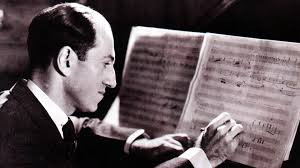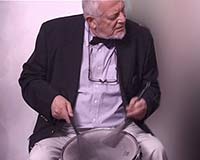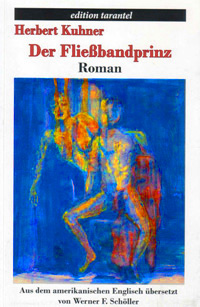“Blackface” is not a slur.
Entertainers who put on black paint
were not putting African Americans down.
In the Twenties and Thirties
those who didn’t need paint
stepped forward
to do their own thing
in spite of Jim Crow
and all the impediments.
They have my admiration
and love!
For all the pain and problems we endured
being black men in America,
we really had some good times.
– Jo Jones
George helped get the ball rolling!
George Gershwin
George Gershwin,
composer,
piano player and pianist,
didn’t have to struggle much
before he caught on.
With people like
Paul Whiteman around to help,
how could he miss?
He was born with the knack
and poured it out easily
till his untimely death
at the age of 38 in ’37.
George was a Brooklyn boy,
who started out as a champion.
He was fastest on roller skates
on his block,
and he’d race along
in the short span
that was his allotment.
When you look at his photos,
you know
that he knew where he was going.
The sultry eyes convey the message.
His nose was a bit too thick,
he had slightly protruding lower lip
and too much jaw,
yet the over-all impression
was suave and hip,
and the clothes: spiffy and collegiate.
He wrote popular songs,
classical pieces,
a folk opera
and music for Broadway shows
and Hollywood films.
He was so prodigious
and worked on so many projects
at one time
that he had to juggle
in order to get things done,
and he got more than a lot done
in his short life.
In ’24, he took ten days to compose
Rhapsody in Blue
and kept it in his hands
till the last minute,
insisting that it wasn’t good enough.
Whiteman’s comment:
“The damn fool,
did he think he could improve it?”
Due to other commitments,
he had Ferde Grofé
orchestrate it.
Did George keep that hectic pace
because he had an inkling
that his life
would be nipped in the bud?
He was aware
of the significance of jazz
and his use of it was natural.
What he touched
turned to gold,
but he interrupted
the lucrative composing
of hit tunes and musical scores
in order to take time to study
music composition,
so that he could blend jazz
with classical forms.
To quote Marvin Hamlish:
„He took the European tradition
bequeathed to all composers
and poured his jazzy soul into it.“
Gershwin himself wrote:
„Jazz is not Negro but American.
It is the spontaneous expression
of the nervous energy
of modern American life.“
Let me humbly beg to differ:
jazz is black as well as American.
Paul Whiteman begged to differ:
“Jazz came to America
three hundred years ago in chains.”
It was the blacks who gave it to us,
but a lot of whites like Gershwin
became part of it
and he was also one
who gave blacks their due.
When Porgy and Bess was completed,
Gershwin stipulated
that it be performed by blacks,
and not in „blackface,“
thus dashing Al Jolson’s plans
to use it as a vehicle for himself
and turn it into a novelty.
That helped
put an end to blackface.
There’d be no more
taking off the color
in dressing rooms
after the show.
Jolson faded away
and Eddie Canter
had to can the black paint.
Blacks were doing
their own thing,
and audiences wanted to see and hear
the real McCoy.
In his last year
Gershwin wrote the score
for an Astaire-Rogers musical
Shall we Dance
and for an Astaire musical
Damsel in Distress
in which the great dancer
does a dance
with a set of drums
as a substitute for missing Ginger.
Fred was the interpreter
of the Thirties for Gershwin songs,
as well as for those of Porter, Kern,
Berlin and many others
and as far as dancing is concerned,
and did anyone come closer to flying
than he and Ginger?
Gershwin songs like
Lady Be Good and I Got Rhythm,
in addition to brightening
films and musicals,
are among the mainstay
of jazz bands and groups.
Gershwin died at the peak
of his creative powers.
What he could have done
had he been able to go on
remains in the field of fantasy.
There was never to be
an old George Gershwin;
there will always be
a young George Gershwin.
– Herbert Kuhner

George Gershwin









 Users Today : 202
Users Today : 202 Users Yesterday : 165
Users Yesterday : 165 This Month : 2184
This Month : 2184 This Year : 19117
This Year : 19117 Total Users : 177212
Total Users : 177212 Views Today : 430
Views Today : 430 Total views : 1867665
Total views : 1867665 Who's Online : 2
Who's Online : 2




